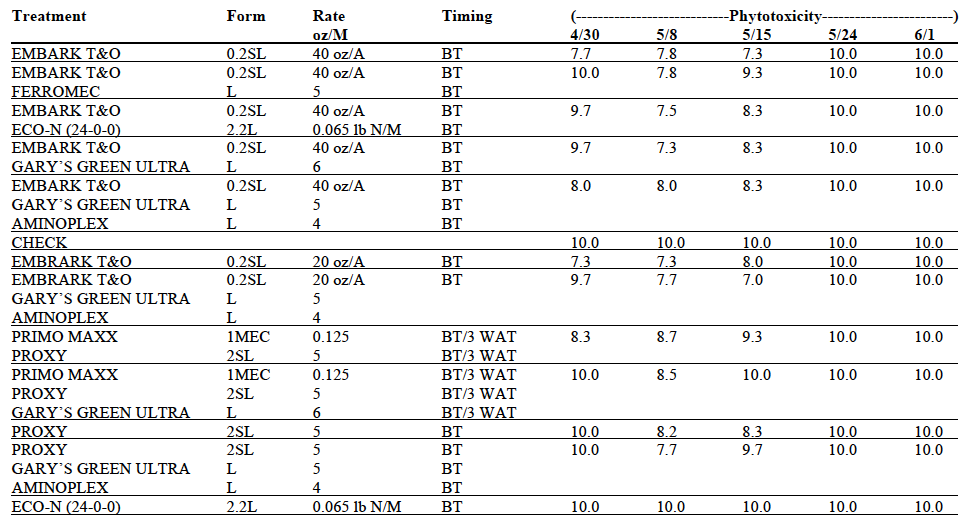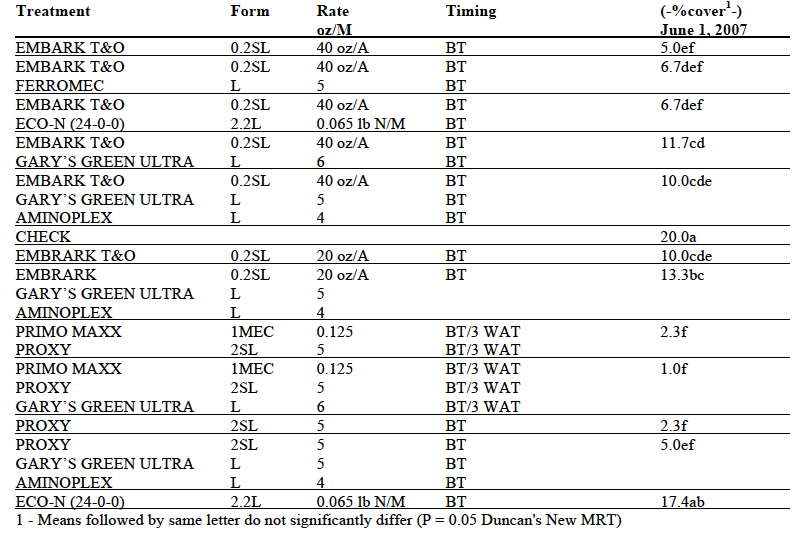Seedhead Suppression of Annual Bluegrass on a Putting Green
Seedhead Suppression of Annual Bluegrass on a Putting Green
J. A. Borger and M. B. Naedel
Introduction
This study was conducted on a mixed stand of ‘Penncross’ creeping bentgrass (Agrostis stolonifera) and annual bluegrass (Poa annua) at the Penn State Blue Golf Course in State College, PA. The objective of the study was to evaluate selected growth regulators, with and without adjuvants, for the seedhead suppression of annual bluegrass.
Methods and Materials
This study was a randomized complete block design with three replications, and a plot size of 21 ft2. Treatments were applied on April 21 (BT), and May 15 (3 WAT), 2007 using a three-foot CO2 powered boom sprayer calibrated to deliver 40 gpa using one 11004E even tip/flat fan nozzle at 40 psi.
The site was maintained using cultural practices for irrigation, mowing, and fertilization that would be typical for a putting green. The test area was mowed with a Toro Triplex with an eleven blade reel, bench set to 0.115”. Prior to the initiation of the study, the site was fertilized with a Nature Safe 8-3-5 fertilizer at a rate of 1 lb N/M in February and again with Anderson’s Contec DG 18-9-18 at a rate of 1lb N/M on May 10, 2007. Boot stage of the annual bluegrass was observed April 27, 2007.
Results and Discussion
Turfgrass phytotoxicity was rated five times during the study (Table 1). There was no phytotoxicity below acceptable (7.0) observed on any rating date.
The percent annual bluegrass seedhead cover was rated once on June 1, 2007 (Table 2). All treated turfgrass had significantly fewer seedhead cover than non treated turfgrass except for the Eco-N only treated turfgrass. It should be noted that turfgrass treated with Primo MAXX plus Proxy alone and Proxy alone were not significantly different than turfgrass treated with Embark T&O. This type of seedhead suppression is unusual and not typical of data observed in prior years at this site. Additionally, it should be noted that the test site had relatively “light seedhead production” during the 2007 season. In 2007 the non treated turfgrass only had 20% coverage of annual bluegrass seedheads in contrast to prior years when the site had 90% or more coverage in non treated areas. The relatively “light pressure” of 2007 may have lead to the increase of suppression that had not previously been observed.
1 Instructor and Research Technician, respectively, Department of Crop and Soil Sciences, Penn State University, University Park, Pa, 16802

Table 1. Ratings of phytotoxicity of an annual bluegrass/creeping bentgrass putting green on a scale of 0 to 10 where 0 = complete phytotoxicity, 7 = acceptable, and 10 = no phytotoxicity in 2007.

Table 2. Ratings of the percent seedhead cover of an annual bluegrass/creeping bentgrass putting green in 2007.